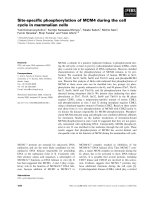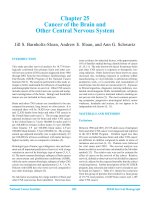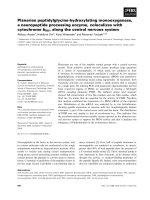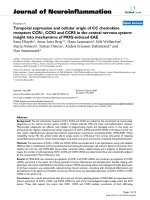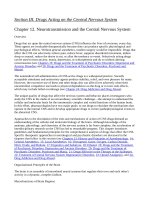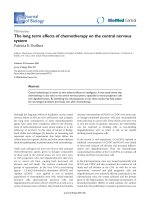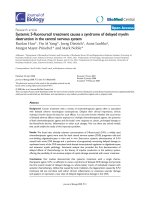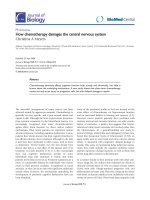The cell cycle in the central nervous system d janigro (humana, 2006)
Bạn đang xem bản rút gọn của tài liệu. Xem và tải ngay bản đầy đủ của tài liệu tại đây (45.11 MB, 554 trang )
The Cell Cycle in the Central Nervous System
Contemporary Neuroscience
The Cell Cycle in the Central Nervous System,
edited by Damir Janigro, 2006
Neural Development and Stem Cells, Second
Edition, edited by Mahendra S. Rao,
2005
Neurobiology of Aggression: Understanding
and Preventing Violence, edited by Mark
P. Mattson, 2003
Neuroinflammation: Mechanisms and
Management, Second Edition, edited by
Paul L. Wood, 2003
Neural Stem Cells for Brain and Spinal Cord
Repair, edited by Tanja Zigova, Evan Y.
Snyder, and Paul R. Sanberg, 2003
Neurotransmitter Transporters: Structure,
Function, and Regulation, Second Edition,
edited by Maarten E. A. Reith, 2002
The Neuronal Environment: Brain Homeostasis
in Health and Disease, edited by Wolfgang
Walz, 2002
Pathogenesis of Neurodegenerative Disorders,
edited by Mark E Mattson, 2001
Stem Cells and CNS Development, edited by
Mahendra S. Rao, 2001
Neurobiology of Spinal Cord Injury, edited
by Robert G. Kalb and Stephen M.
Strittmatter, 2000
Cerebral Signal Transduction: From First to
Fourth Messengers, edited by Maarten E.
A. Reith, 2000
Central Nervous System Diseases: Innovative
Animal Models from Lab to Clinic, edited
by Dwaine F. Emerich, Reginald L.
Dean, III, and Paul R. Sanberg, 2000
Mitochondrial lnhibitors and Neurodegenerative
Disorders, edited by Paul R. Sanberg,
Hitoo Nishino, and Cesario V. Borlongan,
2000
Cerebral lschemia: Molecular and Cellular
Pathophysiology, edited by Wolfgang
Walz, 1999
Cell Transplantation for Neurological
Disorders, edited by Thomas B. Freeman
and H~kan Widner,1998
Gene Therapy for Neurological Disorders
and Brain Tumors, edited by E. Antonio
Chiocca and Xandra O. Breakefield,
1998
Highly Selective Neurotoxins: Basic and
Clinical Applications, edited by Richard
M. Kostrzewa, 1998
Neuroinflammation: Mechanisms and
Management, edited by Paul L. Wood,
1998
Neuroprotective Signal Transduction, edited
by Mark P. Mattson, 1998
Clinical Pharmacology of Cerebral lschemia,
edited by Gert J. Ter Horst and Jakob
Korf, 1997
Molecular Mechanisms of Dementia, edited
by Wilma Wasco and Rudolph E. Tanzi,
1997
Neurotransmitter Transporters: Structure,
Function, and Regulation, edited by
Maarten E. A. Reith, 1997
Motor Activity and Movement Disorders:
Research Issues and Applications,
edited by Paul R. Sanberg, Klaus-Peter
Ossenkopp, and Martin Kavaliers, 1996
Neurotherapeutics: Emerging Strategies,
edited by Linda M. Pullan and Jitendra
Patel, 1996
Neuron-Glia Interrelations During Phylogeny: I1. Plasticity and Regeneration,
edited by Antonia Vernadakis and Betty
I. Roots, 1995
Neuron~THia Interrelations During Phylogeny:
I. Phylogeny and Ontogeny of Glial Cells,
edited by Antonia Vernadakis and Betty I.
Roots, 1995
The Biology of Neuropeptide Y and Related
Peptides, edited by William F. Colmers
and Claes Wahlestedt, 1993
Psychoactive Drugs: Tolerance and Sensitization, edited by A. J. Goudie and M. W.
Emmett-Oglesby, 1989
The Cell Cycle
in the
Central Nervous System
Edited by
Damir Janigro,
PhD
The Cleveland Clinic Foundation, Cleveland, OH
HUMANA
PRESS-~ TOTOWA,NEWJERSEY
© 2006 Humana Press Inc.
999 Riverview Drive, Suite 208
Totowa, New Jersey 07512
humanapress.com
All rights reserved.
No part of this book may be reproduced, stored in a retrieval system, or transmitted in any form or by any means,
electronic, mechanical, photocopying, microfilming, recording, or otherwise without written permission from the
Publisher.
All papers, comments, opinions, conclusions, or recommendations are those of the author(s), and do not necessarily
reflect the views of the publisher.
For additional copies, pricing for bulk purchases, and/or information about other Humana titles, contact Humana at
the above address or at any of the following numbers: Tel.: 973-256-1699; Fax: 973-256-8341; E-mail:
, or visit our Website: www.humanapress.com
This publication is printed on acid-free paper. ~ )
ANSI Z39.48-1984 (American Standards Institute) Permanence of Paper for Printed Library Materials.
Production Editor: Amy Than
Cover Illustration: Fig. 3, Chapter 9, "Nonsynaptic GABAergic Communication and Postnatal Neurogenesis," by
Xiuxin Liu, Anna J. Bolteus, and Ang61ique Bordey (background image); Fig. 13, Chapter 29, "Detection of Proliferation in Gliomas by Positron Emission Tomography Imaging," by Alexander M. Spence et al.; Fig. 3, Chapter 24,
"Vascular Differentiation and the Cell Cycle," by Luca Cucullo; and Fig. 2, Chapter 32, "Cell Cycle of Encapsulated
Cells," by Roberto Dal Toso and Sara Bonisegna (foreground images).
Cover design by Patricia F. Cleary
Photocopy Authorization Policy:
Authorization to photocopy items for internal or personal use, or the internal or personal use of specific clients, is granted
by Humana Press Inc., provided that the base fee of US $30 is paid directly to the Copyright Clearance Center at 222
Rosewood Drive, Danvers, MA 01923. For those organizations that have been granted a photocopy license from the
CCC, a separate system of payment has been arranged and is acceptable to Humana Press Inc. The fee code for users
of the Transactional Reporting Service is: [1-58829-529-X/06 $30].
Priuted in the United States of America. 10 9 8 7 6 5 4 3 2 1 5
elSBN: 1-59745-021-9
Library of Congress Cataloging-in-Publication Data
The cell cycle in the central nervous system / edited by Damir Janigro.
p. cm. -- (Contemporary neuroscience)
Includes bibliographical references and index.
ISBN 1-58829-529-X (alk. paper)
1. Central nervous system--Growth. 2. Cell cycle. 3. Central nervous
system--Differentiation. 4. Central nervous system--Diseases.
I. Janigro, Damir. II. Series.
[DNLM: 1. Central Nervous System--growth & development.
2. Central Nervous System--physiopathology. 3. Cell Cycle. 4. Cell
Differentiation.
WL 300 C39305 2006]
QP370.C44 2006
612.8'22--dc22
2005017540
Preface
For many years, it was widely believed that the cell cycle in the central nervous
system (CNS) was mostly of a prenatal, developmental nature. The concept of adult
neurogenesis remained dormant until recently, while reports of an altered cell cycle
in a damaged CNS gained strength. The discovery that the adult mammalian brain
creates new neurons from pools of stem ceils was a breakthrough in neuroscience.
However, cell cycle regulation and disturbances are also a significant event in the life
of other, nonneuronal cells of the brain (and spinal cord). The Cell Cycle in the Central
Nervous System has been assembled with this in mind, and the authorship reflects these
concepts.
There is still controversy over how to define a mitotic cell and how to study the
relevance of neurogenesis in the CNS. Part I begins with an introduction to some of the
tools that neuroscientists have used to determine mitotic propensity in neurons and
other CNS cells (Dr. Prayson). The relevance of cell expansion and differentiation,
with emphasis on both neuronal and glial cells, is outlined in the chapters by Drs.
Taupin and Bradl. The development of blood vessels and their relevance during brain
development is discussed in the chapter by Dr. Grant and myself, and Drs. Battaglia
and Bassanini describe how impaired cell expansion results in postnatal malformations
of cortical structures.
Neurons and glia, brain parenchyma, and cerebral vasculature are regarded today as
an integrated system rather than an aggregate of different cell types. The concept of a
neurovascular unit is clearly a centerpiece of modem neurobiology. Drs. Walker and
Sikorska open Part II with an illustration of how mass screening of genes and gene
products can be applied to neurogenesis, and Dr. Lo and colleagues describe how the
development of new neurons is counterbalanced by cell death by apoptotic activation.
The brief reviews by Drs. Arcangeli and Becchetti and the contributions by Dr. Bordey
and colleagues, as well as Dr. Yu, introduce a new and provocative role for ion channels and neurotransmitters expressed in the CNS and apparently involved in the process of cell division and mitotic arrest. The renewal of stem cells in the mammalian
brain is introduced by Dr. Arsenijevic.
Part III is devoted specifically to the regulation of cell cycle in glia and how its
regulation may fail in pretumor conditions or following a nonneoplastic CNS response
to injury (see Chapter 12 by Dr. Couldwell and colleagues, and Chapter 13 by Dr.
Hallene and myself). In addition to ion channels (Part II, Chapter 8), evidence suggests
that electrical field potentials are responsible for the relative quiescence of excitable
cells or cells exposed to constant electrical activity (brain, heart, nerve, muscle). This
is presented in the chapter by Dr. Dini and colleagues.
The therapeutic success of neurosurgical resections for the treatment of neurological
disorders challenges the view that more is necessarily better (Part IV). The chapters by
Drs. Taupin and Bengez show that brain injury often translates in cell cycle re-entry.
Whether this may be beneficial, and to what extent, is discussed in a cerebrovascular
vi
Preface
framework by Drs. Kobiler and Glod (Chapter 17), Stanimirovic et al. (Chapter 18),
and Moons et al. (Chapter 19).
The possibility that cell cycle re-entry is actually detrimental is presented in Part V.
Changes in postmitotic neurons in a variety of pathologies are presented by Drs. York
et al., Gustaw et al., Gonzalez-Martinez et al., Eisch and Mandyam, and Casadesus et
al. Dr. Cucullo's chapter expands this to the cerebral vasculature.
Cell cycle control fails during tumorigenesis and brain tumors are not an exception.
Unfortunately, little progress has been made in the treatment of malignant brain
tumors. Part VI focuses on recent advances in the biology and detection of gliomas
(Drs. Spence et al., Aeder and Hussaini, Kapoor and O'Rourke, Zhang and Fine),
as well as drug resistance (Drs. Teng and Piquette-Miller).
The promises of postnatal neurogenesis and the possible pathological significance
of cell cycle re-entry in the central nervous system will greatly influence the neuroscience world in the next several years. There is much hype and controversy surrounding the issue of stem cell research, and also uncertainty concerning the moral and ethical
correlates of what we as scientists can do with molecular manipulation of the human
genome. In some respects, however, the future is already here, and attempts to treat
neurological disorders by gene transfer (Chapter 33), electrical stimulation (Chapter
34), or stem cell introduction (Chapter 35) are presented in Part VII. Drs. DalToso and
Bonisegna address the issue of stem cell rejection by the host in Chapter 32, and Chapter 36 by Dr. Aumayr and myself gives a brief overview of how epigenetic modifications may impact CNS development.
Damir Janigro, PhD
Acknowledgment
I would like to thank my wife, Kim A. Conklin, for many years of uninterrupted
support and encouragement, and Christine Moore for making all this possible.
vii
Contents
Preface ...........................................................................................................................v
Acknowledgment ......................................................................................................vii
Contributors ............................................................................................................xiii
Companion CD .......................................................................................................xvii
Part I. Cell Cycle During the Development of the Mammalian
Central Nervous System
1. M e t h o d o l o g i c a l C o n s i d e r a t i o n s in the E v a l u a t i o n of the Cell Cycle
in the Central N e r v o u s S y s t e m ................................................................... 3
Richard A. Prayson
2. N e u r a l S t e m Cells ............................................................................................. 13
Philippe Taupin
3. Progenitors a n d Precursors of N e u r o n s a n d Glial Cells ........................... 23
Monika Bradl
4. Vasculogenesis a n d A n g i o g e n e s i s ................................................................ 31
Gerald A. Grant and Damir Janigro
5. N e u r o n a l M i g r a t i o n a n d M a l f o r m a t i o n s of Cortical D e v e l o p m e n t ....... 43
Giorgio Battaglia and Stefania Bassanini
Part IL Postnatal Development of Neurons and Glia
6. G e n o m e - W i d e Expression Profiling of N e u r o g e n e s i s in Relation
to Cell Cycle Exit .......................................................................................... 59
P. Roy Walker, Dao Ly, Qing Y. Liu, Brandon Smith,
Caroline Sodja, Marilena Ribecco, and Marianna Sikorska
7. N e u r o g e n e s i s a n d A p o p t o t i c Cell Death ..................................................... 71
Klaus van Leyen, Seong-Ryong Lee, Michael A. Moskowitz,
and Eng H. Lo
8. Ion C h a n n e l s a n d the Cell Cycle ................................................................... 81
Annarosa Arcangeli and Andrea Becchetti
9. N o n s y n a p t i c GABAergic C o m m u n i c a t i o n
a n d Postnatal N e u r o g e n e s i s ...................................................................... 95
Xiuxin Liu, Anna J. Bolteus, and Ang61ique Bordey
10. Critical Roles of Ca 2÷ a n d K ÷ H o m e o s t a s i s in A p o p t o s i s ......................... 105
Shan Ping Yu
ix
x
Contents
11. M a m m a l i a n Neural Stem Cell Renewal ...................................................... 119
Yvan Arsenijevic
Part III. Control of the Cell Cycle and Apoptosis in Glia
12. Methods of Determining Apoptosis in Neuro-Oncology:
Review of the Literature ................................................................................143
Brian T. Ragel, Bardia Amirlak, Ganesh Rao,
and William T. Couldwell
13. Cell Cycle, Neurological Disorders, and Reactive Gliosis ............................. 163
Kerri L. Hallene and Damir Janigro
14. Potassium Channels, Cell Cycle, and Tumorigenesis
in the Central N e r v o u s System ................................................................177
Gabriele Dini, Erin Vo Ilkanich, and Damir Janigro
Part IV. Adult Neurogenesis: A Mechanism for Brain Repair?
15. Enhanced Neurogenesis Following Neurological Disease ...................... 195
Philippe Taupin
16. Endothelial Injury and Cell Cycle Re-Entry ...............................................207
Ljiljana Krizanac-Bengez
17. The Contribution of Bone Marrow-Derived Cells to Cerebrovascular
Formation and Integrity ..............................................................................221
David Kobiler and John Glod
18. Microvessel Remodeling in Cerebral Ischemia .........................................233
Danica B. Stanimirovic, Maria J. Moreno, and Arsalan S. Haqqani
19. Vascular and N e u r o n a l Effects of VEGF in the N e r v o u s System:
Implications for Neurological Disorders ......................................................245
Lieve Moons, Peter Carmeliet, and Mieke Dewerchin
20. Epidermal G r o w t h Factor Receptor in the A d u l t Brain ........................... 265
Carmen Estrada and Antonio Villalobo
Part V. Cell Cycle Re-Entry: A Mechanism of Brain Disease?
21. N e u r o d e g e n e r a t i o n and Loss of Cell Cycle Control
in Postmitotic N e u r o n s ..............................................................................281
Randall D. York, Samantha A. Cicero, and Karl Herrup
22. Cell Cycle Activation and the Amyloid-~ Protein in Alzheimer's Disease .... 299
Katarzyna A. Gustaw, Gemma Casadesus, Robert P. Friedland,
George Perry, and Mark A. Smith
23. N e u r o n a l Precursor Proliferation and Epileptic Malformations
of Cortical D e v e l o p m e n t ............................................................................309
Jorge A. Gonzdlez-MarNnez, William E. Bingaman,
and Imad M. Najm
24. Vascular Differentiation and the Cell Cycle ..............................................319
Luca Cucullo
Contents
xi
25. Adult Neurogenesis and Central Nervous System
Cell Cycle Analysis: Novel Tools for Exploration of the Neural Causes
and Correlates of Psychiatric Disorders ....................................................... 331
Amelia J. Eiseh and Chitra D. Mandyam
26. Neurogenesis in Alzheimer's Disease:
Compensation, Crisis, or Chaos ? .............. .................................................... 359
Gemma Casadesus, Xiongwei Zhu, Hyoung-gon Lee,
Michael W. Marlatt, Robert P. Friedland, Katarzyna A. Gustaw,
George Perry, and Mark A. Smith
Part VI. The Biology of Gliomas
27. p53 and Multidrug Resistance Transporters
in the Central Nervous System ................................................................ 373
Shirley Teng and Micheline Piquette-Miller
28. Signaling Modules in Glial Tumors and Implications
for Molecular Therapy ............................................................................... 389
Gurpreet S. Kapoor and Donald M. O'Rourke
29. Detection of Proliferation in Gliomas by Positron Emission
Tomography Imaging ................................................................................ 419
Alexander M. Spence, David A. Mankoff, Joanne M. Wells,
Mark Muzi, John R. Grierson, Janet F. Eary, S. Finbarr O'Sullivan,
Jeanne M. Link, Daniel L. Silbergeld, and Kenneth A. Krohn
30. Transition of Normal Astrocytes Into a Tumor Phenotype .................... 433
Sean E. Aeder and Isa M. Hussaini
31. Mechanisms of Gliomagenesis ..................................................................... 449
Wei Zhang and Howard A. Fine
Part VII. Future Directions
32. Cell Cycle of Encapsulated Cells .................................................................. 465
Roberto Dal Toso and Sara Bonisegna
33. Viral Vector Delivery to Dividing Cells ...................................................... 477
Yoshinaga Saeki
34. Electrical Stimulation and Angiogenesis:
Electrical Signals Have Direct Effects on Endothelial Cells ....................... 495
Min Zhao
35. Development and Potential Therapeutic Aspects of Mammalian
Neural Stem Cells ....................................................................................... 511
L. Bai, S. L. Gerson, and R. H. Miller
36. Mammalian Sir2 Proteins: A Role in Epilepsy and Ischemia ....................... 525
Barbara Aumayr and Damir Janigro
Index .......................................................................................................................... 541
Contributors
SEANE. AEDER,PhD " Department of Pathology, University of Virginia, Charlottesville, VA
BARDIAAMIRLAK, MD " Department of Neurosurgery, Creighton University, Omaha, NE
Department of Experimental Pathology
and Oncology, University of Firenze, Florence, Italy
YVANARSENIJEVIC, PhD " Unit of Oculogenetics, Department of Ophthalmology, Jules
Gonin Eye Hospital, Lausanne, Switzerland
BARBARAAUMAYR, BS • University of Vienna, Vienna, Austria
L. BAI,MD,PhD " Department of Neurosciences, Case Western Reserve University,
Cleveland, OH
STEFANIA BASSANINI, PhD " Department of Experimental Neurophysiology
and Epileptology, Instituto Neurologico, Milan, Italy
GIORGIO BATTAGLIA, MD " Department of Experimental Neurophysiology
and Epileptology, Instituto Neurologico, Milan, Italy
ANDREABECCHETTI, PhD • Department of Biotechnology and Bioscience, Universitd
di Milano-Bicocca, Milano, Italy
WILLIAM E. BINGAMAN, MD " Department of Neurosurgery, The Cleveland Clinic
Foundation, Cleveland, OH
ANNA J. BOLTEUS, PhD • Department of Neurosurgery, Cellular and Molecular
Physiology, Yale University School of Medicine, New Haven, CT
SARA BONISEGNA, PhD " Biosil-USA, Wilmington, DE
ANGI~LIQUE BORDEY,PhD " Department of Neurosurgery, Cellular and Molecular
Physiology, Yale University School of Medicine, New Haven, CT
MONIKA BRADL,PhD " Center for Brain Research, Department of Neuroimmunology,
Medical University Vienna, Vienna, Austria
PETERCARMELIET, MD,PhD " Centerfor Transgene Technologyand Gene Therapy, Flanders
Interuniversity Institutefor Biotechnology,UniversityofLeuven, Leuven, Belgium
GEMMACASADESUS, PhD • Institute of Pathology, Case Western Reserve University,
Cleveland, OH
SAMANTHAa . CICERO " Alzheimer Research Lab, Department of Physiology,
Case Western Reserve University, Cleveland, OH
WILLIAM T. COULDWELL, MD, PhD " Department of Neurosurgery, University of Utah
Hospital, Salt Lake City, UT
LucA CUCULLO, PhD " CerebrovascularResearch Laboratory, Department
of Neurosurgery, The Cleveland Clinic Foundation, Cleveland, OH
ROBERTO DAL TOSO, PhD " Biosil-USA, Wilmington, DE
MIEKEDEWERCHIN,PhD " Centerfor Transgene Technologyand Gene Therapy, Flanders
Interuniversity Institute for Biotechnology, University of Leuven, Leuven, Belgium
GABR1ELEDINI, PhD • CerebrovascularResearchLaboratory,Department of Neurosurgery,
The Cleveland Clinic Foundation, Cleveland, OH
ANNAROSA ARCANGELI, MD, PhD •
xiii
xiv
Contributors
Department of Radiology, University of Washington School
of Medicine, Seattle, WA
AMELIA J. EiscH, PhD • Department of Psychiatry, University of Texas Southwestern
Medical Center, Dallas, TX
CARMEN ESTRADA, MD, PhD " Department of Physiology, Facultad de Medicina,
University of Cddiz, Cddiz, Spain
HOWARD A. FINE, MD " Neuro-Oncology Branch, Centerfor Cancer Research,
National Cancer Institute, Bethesda, MD
ROBERT P. FRIEDLAND, MD " Laboratory of Neurogeriatrics, Department of Neurology,
Case Western Reserve University, Cleveland, OH
S. L. GERSON,MD * Cancer Center, Case Western Reserve University, Cleveland, OH
JOHN GLOD, MD, PhD " The Cancer Institute of New Jersey, New Brunswick, NJ
JORGE A. GONZALEZ-NIARTiNEZ,ME),PhD " Department of Neurosurgery, The Cleveland
Clinic Foundation, Cleveland, OH
GERALDA. GRANT, MD • Director of Pediatric Neurosurgery, Wilford Hail Medical
Center, Lackland Air Force Base, TX
JOHN R. GRIERSON,PhD " Department of Radiology, University of Washington School
of Medicine, Seattle, WA
KATARZYNA A. GUSTAW, MD " Department of Neurodegenerative Diseases, Institute
of Agricultural Medicine, Lublin, Poland
KERI~ L. HALLENE, BS " CerebrovascularResearch Library, Department of Neurological
Surgery, The Cleveland Clinic Foundation, Cleveland, OH
ARSALAN S. HAQQANI, PhD • Institute for Biological Sciences, National Research
Council of Canada, Ottawa, Ontario, Canada
KARL HERRUP, PhD " Alzheimer Research Lab, Department of Neuroscience, Case
Western Reserve University Medical School, Cleveland, OH
ISA M. HUSSAn'a,PhD " Department of Pathology, University of Virginia, Charlottesville, VA
ER~ V. ILKANICH,BS * Cerebrovascular ResearchLaboratory, Department of Neurosurgery,
The Cleveland Clinic Foundation, Cleveland, OH
DAMm JANIGRO,PhD " CerebrovascularResearch Laboratory, Department of Neurosurgery,
The Cleveland Clinic Foundation, Cleveland, OH
GURPREETS. K A P O O R , P h D " Department of Neurosurgery, The Hospital of the University
of Pennsylvania, Philadelphia,PA
DAVID KOB1LER, PhD " Department of Infectious Diseases, Israel Institute for Biological
Research, Ness-Ziona, Israel
LJILJANA KRIZANAC-BENGEZ, MD, PhD • Cerebrovascular Research Laboratory,
Department of Neurosurgery, The Cleveland Clinic Foundation, Cleveland, OH
KENNETH a . KROHN, PhD " Department of Radiology, University of Washington
School of Medicine, Seattle, WA
SEONG-RYONG LEE, MD, PhD " Neuroprotection Research Laboratory, Harvard Medical
School, Charlestown, MA
HYOUNG-GON LEE, PhD • Institute of Pathology, Case Western Reserve University,
Cleveland, OH
JEANNE M. LINK, PhD " Department of Radiology, University of Washington School
of Medicine, Seattle, WA
JANET F. GARY,MD "
Contributors
xv
NeuroGenomics Group, Institute for Biological Sciences, National
Research Council of Canada, Ottawa, Ontario, Canada
XIUXIN L1U, PhD " Department of Neurosurgery, Cellular and Molecular Physiology,
Yale University School of Medicine, New Haven, CT
ENG H. LO, PhD " Neuroprotection Research Laboratory, Harvard Medical School,
Charlestown, MA
DAO LY, BSc • NeuroGenomics Group, Institute for Biological Sciences, National
Research Council of Canada, Ottawa, Ontario, Canada
CHITRA D. MANDYAM, PhD " Department of Psychiatry, University of Texas Southwestern
Medical Center, Dallas, TX
DAVID a . MANKOFF, MD, PhD • Department of Radiology, University of Washington
School of Medicine, Seattle, WA
MICHAEL W. MARLATT, MS • Institute of Pathology, Case Western Reserve University,
Cleveland, OH
R. H. MILLER, PhD " Department of Neurosciences, Case Western Reserve University,
Cleveland, OH
LIEVE MOONS, PhD " Centerfor Transgene Technology and Gene Therapy, Flanders
Interuniversity Institute for Biotechnology, University of Leuven, Leuven, Belgium
MARIA J. MORENO, PhD " Institute for Biological Sciences, National Research Council
of Canada, Ottawa, Ontario, Canada
MICHAEL a . MOSKOWITZ, MD • Department of Neurology, Massachusetts General
Hospital, Charlestown, MA
MARK MuzI, MS • Department of Radiology, University of Washington School
of Medicine, Seattle, WA
IMAD M. NAJM, MD • Department of Neurology, The Cleveland Clinic Foundation,
Cleveland, OH
DONALDM. O'ROURKE, MD • Department of Neurosurgery, The Hospital of the University
ofPennsylvania, Philadelphia,PA
S. FINBARRO'SULLIVAN, PhD • Department of Statistics, University of Cork, Cork, Ireland
GEORGE PERRY,PhD " Institute of Pathology, Case Western Reserve University,
Cleveland, OH
MICHELINE PIQUETTE-MILLER,PhD • Faculty of Pharmacy, University of Toronto,
Toronto, Ontario, Canada
RICHARDA. PRAYSON, MD • Department of Anatomic Pathology, The Cleveland Clinic
Foundation, Cleveland, OH
BRIAN T. RAGEL, MD • Department of Neurosurgery, University of Utah Hospital,
Salt Lake City, UT
GANESH RAO, MD • Department of Neurosurgery, University of Utah Hospital,
Salt Lake City, UT
MARILENA RIBECCO, PhD • NeuroGenomics Group, Institute for Biological Sciences,
National Research Council of Canada, Ottawa, Ontario, Canada
YOSHINAGA SAEKI, MD, PhD • The Dardinger Laboratoryfor Neuro-Oncology
and Neurosciences, Ohio State University Medical Center, Columbus, OH
MARIANNA SIKORSKA, PhD • NeuroGenomics Group, Institute for Biological Sciences,
National Research Council of Canada, Ottawa, Ontario, Canada
QING Y. LIu, PhD "
xvi
Contributors
Department of Neurosurgery, University of Washington
School of Medicine, Seattle, WA
MARK A. SMITH, PhO • Institute of Pathology, Case Western Reserve University,
Cleveland, OH
BRANDONSMITH, MSc " NeuroGenomics Group, Institute for Biological Sciences,
National Research Council of Canada, Ottawa, Ontario, Canada
CAROLINESODJA, MSc • NeuroGenomics Group, Institute for Biological Sciences,
National Research Council of Canada, Ottawa, Ontario, Canada
ALEXANDERM. SPENCE, MD • Department of Neurology, University of Washington
School of Medicine, Seattle, WA
DANICA B. STANIMIROVIC,MD, PhD • Institute for Biological Sciences, National
Research Council of Canada, Ottawa, Ontario, Canada
PHILIPPETAUPIN, PhD" National Neuroscience Institute, National University
of Singapore, Singapore
SHIRLEYTENG, PhD " Faculty of Pharmacy, University of Toronto, Toronto, Ontario,
Canada
KLAUS VAN LEYEN, PhD • Neuroprotection Research Laboratory, Harvard Medical
School, Charlestown, MA
ANTONIO VILLALOBO,MD, PhD • Institute oflnvestigational Biomedicine, University
of Madrid, Madrid, Spain
P. Roy WALKER, PhD " NeuroGenomics Group, Institute for Biological Sciences,
National Research Council of Canada, Ottawa, Ontario, Canada
JOANNE M. WELLS, MS • Department of Radiology, University of Washington School
of Medicine, Seattle, WA
RANDALLDo YORK, PhD" Alzheimer Research Lab, Department of Neuroscience,
Case Western Reserve University, Cleveland, OH
SHAN PING YU, MD, PhD • Department of Pharmaceutical Sciences, School
of Pharmacy, Medical University of South Carolina, Charleston, SC
WEI ZHANG, MD, PhD" Neuro-Oncology Branch, Centerfor Cancer Research, National
Cancer Institute, Bethesda, MD
MIN ZHAO, MD, PhD " Biomedical Sciences, Institute of Medical Sciences, University
of Aberdeen, Aberdeen, Scotland, UK
XIONGWEIZHU, PhD" Institute of Pathology, Case Western Reserve University,
Cleveland, OH
DANIEL L. SILBERGELD, MD "
Companion CD
Color versions of illustrations listed here are presented on the Companion CD
attached to the inside back cover. The image files are organized into folders by chapter
number and are viewable in most Web browsers. The number following "f" at the end
of the file name identifies the corresponding figure in the text. The Companion CD is
compatible with both Mac and PC operating systems.
CHAPTER4
CHAPTER6
CHAPTER 8
CHAPTER 10
CHAPTER 12
CHAPTER 13
CHAPTER 18
CHAPTER 19
CHAPTER 23
CHAPTER 24
CHAPTER 31
CHAPTER 32
CHAPTER 36
FIG. 1
FIG. 1
FIG. 1
FIGS. 1 AND 2
FIGS. 1 AND 2
FIG. 1
FIGS. 2 AND 3
FIGS. 1-3
FIGS. 1--3
FIGS. 1, 3--5
FIGS. 1 AND 3
FIGS. 1--3
FIGS. 1 AND 4
xvii
I
CELL CYCLE DURING THE DEVELOPMENT
OF THE MAMMALIAN CENTRAL
NERVOUS SYSTEM
1
Methodological Considerations in the Evaluation
of the Cell Cycle in the Central Nervous System
Richard A. Prayson, MD
SUMMARY
A number of modalities have been used in the evaluation of cell cycle proliferation in the
central nervous system. The evolution of technology has moved from the routine hematoxylin
and eosin stained assessment of mitotic activity to radiolabeling and flow-cytometric methodologies and more recently reliable immunohistochemical approaches. This chapter will review
the methodological considerations of each of these modalities and their role in the evaluation of
lesions in the central nervous system.
Key Words: Cell proliferation; mitoses; bromodeoxyuridine; flow cytometry; Ki-67; PCNA;
thymidine labeling; MIB-1.
1. C E L L C Y C L E
The cell cycle is the process by which eukaryotic cells undergo cell division. For cell division
to be successful, DNA needs to be faithfully replicated and identical chromosomal copies need
to be distributed equally among two offspring cells. The process by which this occurs is orderly
and remarkably accurate. A whole host of factors are involved in the regulation of the cell cycle.
When such regulation becomes aberrant, the end result is often an atypical proliferation of cells
resulting in a pathological condition; the prototypical example of this scenario is neoplasia.
There are a variety of stimuli responsible for inducing a cell to undergo cell division or mitosis (1-5). Many of these are protein factors which bind to the surface of the cell receptors and
signal the cell that is in the resting phase (Go) to enter into the cell cycle (i.e., the gap-1 [G1]
phase). Among the more important molecules responsible for this progression are the cyclindependent kinases, which are responsible for phosphorylating regulatory proteins. During the
G 1 phase, the cell grows and begins production of elements required for DNA synthesis. Cells
in the G 1 phase have a diploid number of chromosomes, one set inherited from each parent.
Rapidly proliferating cells in humans may progress through the full cell cycle in about 24 h. The
G 1 phase may take approx 8-10 h to complete.
The cell then progresses into the synthesis phase (S phase), during which DNA synthesis
occurs and chromosomal DNA is replicated. During the S phase, cyclin A-cyclin-dependent
kinases 2 complex plays an important role in both the initiation and maintenance of DNA synthesis. The S phase typically takes approx 10 h for completion. The S phase is followed by a 4-5 h
gap-2 (G2) phase. During the G 2 phase, the cell ensures that DNA replication is complete and
that DNA damage is repaired prior to the cell entering the mitotic phase of the cell cycle. On
entering the mitotic phase, which typically lasts less than 1 h in duration, the cell undergoes a
series of events in the process of cell division. The initial portion of the mitotic phase is referred
to as prophase. During prophase, the chromosomes become visible as extended double structures.
From: The Cell Cycle in the Central Nervous System
Edited by: D. Janigro © Humana Press Inc., Totowa, NJ
4
Prayson
By light microscopy, they become shorter and more visible, with each chromosome being composed of two daughter DNA molecules with associated histones and other chromosomal proteins.
During metaphase, the kinetochore assembles at each centromere. The kinetochores of sister
chromotids then associate with microtubules coming from opposite spindle poles. The chromosomes are aligned at the equator of the cell. The cell then progresses into anaphase, during which
the chromosome pairs split and move to opposite poles of the cell. Once chromosome separation
has occurred, the mitotic spindles disassemble and the chromosomes decondense during
telophase, with the end product being two daughter cells, each containing a complete set of the
chromosomal material. Cells may either go on to G 1 phase or can enter the G Ophase.
2. M I T O S I S C O U N T S
Possibly, the oldest method for assessing cell proliferation and active division of cells has been
the evaluation of mitosis counts. The methodology has long been the gold standard for evaluating
proliferative activity in a lesion. The diagnosis of many neoplasms is often dependent on an
evaluation of mitotic activity. The method has the advantage of being cheap and can be performed with relative ease on routinely processed, hematoxylin and eosin stained histological
sections. Obviously, evaluation of mitotic figures in tissue sections only captures those cells that
are in the M phase of the cell cycle, which is a relatively short portion of the entire cycle.
A number of factors affecting mitosis counts that are important to consider have been
described. Delays in fixation time, temperature at which the specimen is stored prior to fixation,
and the quality or type of fixative used may all potentially impact on mitosis counts (6-13). The
rate of penetration of the fixative and the size of the tissue specimen being fixed can result in
degenerative changes, particularly in unfixed areas of the tissue, which may make identification
of mitotic figures more difficult. There is some debate in the literature regarding the relative
importance of delays in fixation and their effect on mitosis counts. It appears that cells can
either enter or exit the cell cycle after removal from the body. The apparent decrease in mitotic
activity that has been described by some as being attributable to delays in fixation are most
likely related to the inability to identify mitotic figures in cells that are undergoing degenerative
changes. Decreased temperature (e.g., as a result of refrigeration) may slow these degenerative
changes that make identification of mitotic figures less difficult. The type of fixative used may
also affect one's ability to recognize mitotic figures. Fixatives with low pH and including mercurycontaining compounds, such as Bouin's fixative, tend to increase tissue and cell shrinkage,
resulting in smaller sized nuclei (14). Recognition of mitotic figures in smaller sized cells may
be more difficult. Formalin fixative that is inadequately buffered may also have a lower pH and
induce similar morphological alterations.
In addition to the issues of fixation, tissue staining and sectioning may also influence one's
assessment of mitotic activity (15-18). The presence of nuclear pyknosis, nuclear folding, or nuclear
hyperchromasia may result in morphological changes resembling mitotic figures. With thicker
tissue sectioning, increased numbers of mitotic figures in a given microscopic field may be generated
and may also create a challenge in terms of identifying figures in multiple planes of focus.
Different methodologies for actually reporting mitotic activity have also been promulgated. The
different methodologies may result in significantly different mitosis counts. One of the more common approaches is to evaluate the number of mitotic figures present in a certain number of highpower fields. Interestingly, the area of a high-power field can vary considerably depending on the
make of microscope (19). In 1981, Ellis and Whitehead noted high-power field areas ranging from
0.071 to 0.414 mm 2 in their survey of 26 microscopes of different makes and specifications.
Therefore, more precise reporting of mitotic activity per certain number of high-power fields
should include a calculated area of the high-power field. In the evaluation of particularly cellular
specimens, such as tumors, or specimens with mixed populations of cells, the identification of a
mitotic figure with a particular cell type may be difficult. The number of high-power fields that are
assessed can also vary, depending on the methodology. Some advocate scanning the whole slide to
find an area with the highest mitotic activity and report the single highest count per contiguous
Methodological Considerations
5
Fig. 1. Anaplastic meningioma with readily identifiable mitotic activity. The current World Health
Organization guidelines for the diagnosis of anaplastic (malignant) meningioma grade III includes a high
mitotic index--20 or more mitoses per 10 high-power fields, defined as 0.16 mm2 (hematoxylin and eosin,
original magnificationx400).
10 high-power fields (20); others advocate randomly selecting a field to commence counting and
to evaluate 40 or 50 consecutive high-power fields. The differences in the final results obtained by
using these two different approaches may be strikingly different (20).
The experience of the individual assessing mitotic activity is also an important factor, albeit
frequently unrecognized (15,16,21). The number of artifacts that can be generated associated
with fixation and staining can be problematic at times even for the most experienced morphologist. Apoptotic cells and inflammatory cells may also mimic mitotic figures. One is advised to
count certain mitotic figures only.
The assessment of central nervous system lesions for mitotic activity is generally an exercise
reserved for the evaluation of certain tumors. Mitotic activity can be observed in association
with inflammatory and reactive conditions, particularly in areas of granulation tissue with small
vessel and fibroblastic proliferation. In general, mitotic figures are not seen in association with
gliosis, in which the histological changes are predominantly that of hypertrophy of cells rather
than marked hyperplasia. With certain tumors, criteria have been developed in which the evaluation of mitotic activity is important. This has been particularly well defined in the setting of
meningiomas, in which the current World Health Organization grading system incorporates
mitosis counts in defining atypical and anaplastic meningiomas (22) (Fig. 1). Identification of
morphologically atypical mitotic figures has classically been viewed as a feature of neoplasia
6
Prayson
Fig. 2. An atypical mitotic figure (arrow) in a metastatic breast carcinoma in the central nervous system
(hematoxylin and eosin, original magnification ×525).
(Fig. 2). Unfortunately, differentiation of abnormal from normal mitotic figures is not always
straightforward, and in some cases, tends to be quite observer-dependent.
3. T H Y M I D I N E L A B E L I N G
Among some of the earliest approaches for alternatively evaluating cell cycle were thymidine
labeling and bromodeoxyuridine labeling. In contrast to mitotic activity, evaluation of tritiated
thymidine labeling is an assessment of predominantly the S phase of the cell cycle (Fig. 3). This
approach is predicated on the incorporation of a radioactively labeled DNA precursor (thymidine) into cells during the S phase of the cell cycle. This approach may also be used to measure
the duration of the cell cycle (23,24).
In the evolution of the methodology, earlier, patients were infused with a radioactive agent
prior to surgery. The tissue harvested at surgery was processed routinely and an evaluation of the
incorporation of radioactive labeling was assessed (25,26). In vitro approaches using tissue samples that have already been removed were later developed (27,28). These involved utilization of a
freshly excised tissue and assessing incorporation of the tritiated thymidine. Tissue sections were
incubated with the tritiated thymidine prior to fixation and processing. Various conditions including incubation in a hyperbaric environment or use of 5-fluorouridine 2"deoxy-S-fluorouridine as
potentiating agents can facilitate the uptake of thymidine. Sections are generated and developed
Methodological Considerations
A
7
G= M
B
s~ i G,
G2 M
S ~
G1
Tritiatedthymidine/bromodeoxyuridineHistonemRNAinsituhybridization
C
G=
M
D G, M
S ~ iG' S ~ GI
E
Flow cytometry
G, M
s ~
F
S
t Gt
PCNA
S ~
iG'
Topoisomerase
II-alpha
G G, M
DNApolymerase
alpha
G2 M
H
G1
p105
G, M
s ~ G I
Ki-67/ MIB-1
Fig. 3. The figure summarizes the portions of the cell cycle that are assessed (shaded areas) with various
methodologies.
using autoradiographic methodologies. Labeling indexes can be calculated by determining a percentage of positive-staining cells.
There are several known potential drawbacks to this approach. The radioactive procedure
requires either infusion of the patient prior to the removal of tissue or a fresh tissue. The utilization of the radioactive isotope and all of the concomitant issues that entails needs to be considered. The methodology is also somewhat drawn out, and frequently takes around 7-10 d before
results are obtained. There are also issues regarding the interpretation of results and deciding
what exactly represents a positive finding.
8
Prayson
Bromodeoxyuridine is a thymidine analog which similarly allows for the assessment of the
S phase of the cell cycle. Initially developed as a radioactive methodology, more recent alternative
ways of evaluating bromodeoxyuridine using nonradioactive methodologies including immunohistochemistry, flow cytometry, and immunofluorescence methodologies have been devised
(29,30). Both in vivo and in vitro approaches have been used and, in general, results are somewhat
comparable, although labeling indices in the in vivo method tend to be slightly higher (31).
4. H I S T O N E E V A L U A T I O N
Another method for evaluating the S phase of the cell cycle is the in situ histone hybridization (32-34). Histones are a group of nuclear proteins whose production is generally restricted
to the S phase of the cell cycle. Because histone mRNA has a half-life of approx 10 min, evaluation of histone-3 or histone-4 mRNA allows for a somewhat specific evaluation of the S phase
(35). Fresh or formalin-fixed materials can be evaluated, allowing for retrospective evaluation of
tissues. Problems related to the loss of mRNA or inability of the probe to reach the target mRNA
when fixed tissues are used may limit its utility in certain circumstances, owing to underestimating
the true rate of proliferation.
5. F L O W C Y T O M E T R Y
Evaluation of tissues using flow cytometry and image cytometric analysis systems allows for
a broader assessment of cell proliferation. The methodology is based on an evaluation of cell
DNA content by staining the DNA (36). Either a Feulgen staining procedure or the use of fluorescent markers, such as propidium iodide, can stoichiometrically bind to the DNA, with the
intensity of staining being directly related to the amount of DNA present in the cell. This
methodology is particularly useful in identifying cells which have increased DNA content, corresponding to the S, G 2, and M phases of the cell cycle. Results may be reported numerically or
in a histogram formation.
Both fresh and fixed tissue samples may be used, although better results are usually obtained
when fresh tissue is used (37). Use of archived tissue may result in the generation of increased cellular debris or fragmentation, which may confound the results. The procedure requires a tissue
sample of sufficient size in order to obtain enough cells for proper analysis. The approach does
provide a fairly rapid evaluation of a large number of cells in a relatively short period of time. In
contrast to manually assessed, immunohistochemical methodologies, thresholds for what represents a positive result can be set, thereby minimizing problems related to intraobserver variability.
In contrast to immunohistochemical approaches which allow for the visual localization of staining,
the triage of tissues for flow-cytometric evaluation is often somewhat blinded. Specimens may
contain tissue elements that are not the target of evaluation, which may skew one's results. For
example, vascular proliferative areas in a high-grade glioma may falsely increase the apparent rate
of proliferation in the tumor itself. Similarly, incorporation of a non-neoplastic tissue in the evaluation of a diploid tumor may affect one's results. Use of microdissection techniques or histological
evaluation of tissues prior to triage can eliminate or minimize some of these problems. The presence of overlapping aneuploid peaks may make accurate determination of the S phase difficult.
Finally, the cost of the procedure, particularly the equipment, is considerably more than the cost
associated with immunohistochemical methodologies. Results obtained using flow-cytometric
approaches generally correlate well with immunohistochemical methodologies.
6. I M M U N O H I S T O C H E M I C A L
METHODOLOGIES
A variety of antibody markers have been developed over the past two decades, which allow
for a ready evaluation of cell proliferation. These approaches have the advantage of being relatively easy to perform, are relatively cost-effective, and provide quick results.
DNA polymerase ~ is a cell cycle-related enzyme that is expressed during the G l, S, G 2, and
M phases of the cell cycle (38-40). The protein does not survive formalin fixation and routine
Methodological Considerations
9
histological processing and the staining requires a fresh or a frozen tissue. Similar to DNA polymerase ~, p105 is expressed during similar phases of the cell cycle, p105 is a nuclear associated
protein which may play a role in the production of mature RNA transcripts involved with cell
cycle progression (41-44). The expression of this protein may vary during different phases of
the cell cycle, resulting in a gradation of staining intensity which may be difficult to interpret
and limit its utility as a marker yielding reproducible results. Either fresh or fixed tissues can be
evaluated with this antibody.
DNA topoisomerase-II ~xis a protein involved with untangling DNA strands prior to the cell
entering mitosis (45). The enzyme is produced in the late G l and S phases of the cycle and may
be present during the G 2 and M phases, during which it begins to undergo degradation (46-48).
Archival materials may be used for evaluation.
Proliferating cell nuclear antigen (PCNA) is a nonhistone nuclear protein that is associated
with the function of DNA polymerase 8. Numerous monoclonal antibodies to PCNA have been
developed, which recognize different forms of the protein and are localized to different regions
of the cell nucleus (49). PCNA expression varies during different phases of the cell cycle; its
production increases during the G l phase, remains increased during the S phase, and diminishes
during the G 2 and M phases. Similar to p105, this variability of expression results in variable
staining intensity that may be difficult to interpret. The presence of low levels of PCNA in noncycling GOcells and the long half-life of PCNA (approx 20 h) may also further complicate the
interpretation. Either fresh or fixed tissues may be evaluated. The variability of PCNA antibodies
that are currently available, each recognizing a slightly different epitope, can result in some
differences in staining and be reflective of slightly different cell cycle distributions.
Probably, the most reliable and widely used marker of cell proliferation is Ki-67 or MIB-1
antibody. The Ki-67 antibody was generated by immunizing mice with the nuclei of a Hodgkin's
lymphoma cell line (50). The specific isotope associated with Ki-67 remains unknown, although
the gene associated with it is situated on chromosome 10. The antigen is expressed during a portion of the G 1 phase and in the S, G a, and M phases of the cell cycle (51). When initially manufactured, it was restricted for use with fresh or frozen tissue. In early 1990s, the monoclonal
antibody MIB-1 was developed to the Ki-67 antigen that was able to be used with formalinfixed materials (52) and benefited from microwave processing to enhance antigen retrieval (53).
More recently, Ki-67 antibodies which work on fixed tissue have been developed.
Several methodological considerations are important to recognize when using the Ki-67 antibody. Selection of the tissue sample to evaluate is an important consideration. Not all lesions
demonstrate uniform cell proliferation. This is particularly true for many gliomas which are
well-known to be heterogeneous in terms of cell proliferation (Fig. 4). A variety of technical
aspects can affect staining. The source or type of antibody used, and dilution of antibody and
staining conditions including buffers used can affect staining results (54). Delays in formalin
fixation do not appear to affect Ki-67 staining.
The approach to evaluating and reporting the staining results can be variable. By convention,
similar to assessing mitotic activity, the most proliferative area (region with the highest staining)
is assessed. Only nuclear staining is interpreted as positive. An attempt is made to evaluate only
the cells of interest; double-immunolabeling can be sometimes useful in this endeavor. For
example, if one is interested in evaluating cell proliferation among microglial cells, doublelabeling with Ki-67 and CD68 antibodies might be an useful approach. A determination of what
degree of staining will be interpreted as positive must also be made and will obviously vary
from individual to individual. Some have advocated the use of image analysis systems to address
this issue. Such systems can allow for the ready assessment of large numbers of cells and can set
a uniform staining threshold of positivity. The results are typically reported as a labeling index,
reflecting a percentage of positive-staining cells per total number of cells of interest that are
being evaluated.
Studies that have evaluated interobserver variability in the determination of labeling indices
have noted significant differences among observers, reflective of many of the previously
10
Prayson
Fig. 4. Two contiguous high magnification fields of glioblastoma multiform immunostained with MIB-1
antibody to highlight the regional variability in cell proliferation that marks many gliomas (MIB-1 immunostained, original magnification ×400).
enumerated issues (55,56). Given this variability, one should be cautioned against the establishment of specific cutoff values for the purpose of clinical diagnosis or prognostication.
ACKNOWLEDGMENT
Special thanks are given to Denise Egleton for her help in the preparation of this manuscript.
REFERENCES
1. Dirks PB, Rutka JT. Current concepts in neuro-oncology: The cell cycle--a review. Neurosurgery
1997;40:1000-1015.
2. Heichman KA, Roberts JM. Rules to replicate by. Cell 1997;79:557-562.
3. Laskey RA, Fairman MP, Blow JJ. S phase of the cell cycle. Science 1989;246:609-614.
4. Nurse P. Regulation of the eukaryotic cell cycle. Eur J Cancer 1997;7:1002-1004.
5. Iliakis G. Cell cycle regulation in irradiated and nonirradiated cells. Semin Oncol 1997;24:602-615.
6. Baak JPA. Mitosis counting in tumors. Hum Pathol 1990;21:683-685.
7. Bergers E, Jannink I, van Diest PI, et al. The influence of fixation delay on mitotic activity and flow
cytometric cell cycle variables. Hum Pathol 1997;28:95-100.
